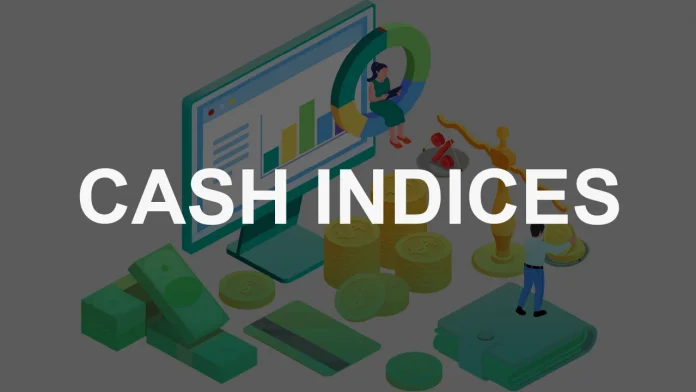Cash Indices are financial instruments that measure the performance of a group of stocks. Trading them can offer several benefits and drawbacks. It’s no secret that this type of trading can be incredibly lucrative, but it’s not without its risks. Before jumping in, it’s important to understand what those risks are and how to mitigate them.
To mitigate the risks of index trading, it’s essential to have a solid risk management plan that includes position sizing, stop-loss orders, hedging strategies, and contingency plans for different scenarios. Proper education, training, and practice are crucial to becoming a successful index trader.
This means studying market analysis, trading psychology, money management, and other relevant topics, as well as testing your strategies in a simulated or low-risk environment before committing to real capital. Monitor your performance, learn from your mistakes, and adjust your approach as needed to stay ahead of the curve.
What Are Cash Indices
The Cash Indices are a set of financial indices that measure the performance of the cash markets. They are used by traders to gauge the strength of the market and to make trading decisions. for example:
Dow Jones Industrial Average (DJIA), S&P 500 Index, NASDAQ Composite Index, and Russell 1000 Index. These indices are widely followed by traders and investors alike and provide a good indication of the overall health of the US stock market.
It is important to note that they only represent a small portion of the market and should not be used as a sole indicator when making investment decisions.
Pros and Cons
When it comes to the pros and cons of Indices trading, there are a few things to consider.
On the plus side – Cash Indices offer several advantages and can be traded easily through financial brokers such as easyMarkets. For example, they provide traders with a way to trade the major US indexes without having to trade individual stocks. They also offer tight spreads and low commissions, which can make them very attractive to active traders.
On the downside – there are a few risks to be aware of when trading Cash Indices. First of all, because they are based on cash rather than futures contracts, they can be subject to significant price gaps when the market opens or during times of high volatility.
Additionally, while the commissions and spreads may be low, the overall costs of trading the Cash Indices can still add up if you’re not careful.
It’s important to remember that the indices only represent a small slice of the overall market, if you’re looking to get exposure to large-cap stocks, for example, you’ll need to look elsewhere.
Overall, then, there are both pros and cons to trading Cash Indices. If you’re aware of the risks and costs involved, and you have a solid trading strategy in place, they can be a great way to get exposure to the US stock market.
The Risks Involved
The risks of trading Cash Indices are manifold and complicated. They can be broadly grouped into three categories – (1) market risk, (2) counterparty risk, and (3) liquidity risk.
- Market Risk – This is the possibility that the value of an asset will decrease due to changes in market conditions. For example, if there is a sudden sell-off in the stock market, the value of cash indices will likely fall as well.
- Counterparty Risk – This is the risk that one party to a transaction will not fulfill its obligations. For example, if a broker goes bankrupt, traders may not be able to get their money back.
- Liquidity Risk – This is the risk that an asset cannot be sold quickly enough to prevent a loss. For example, if there is a sudden increase in selling pressure, the price of an index may drop sharply before buyers have a chance to step in.
When trading Cash Indices, there are a few risks to be aware of. First, the markets are highly volatile and can move quickly, so it’s important to have a firm understanding of your entry and exit points before entering a trade. Second, you’ll need to have enough capital to cover any potential losses, as these can add up quickly in fast-moving markets.
Finally, be aware of the “spread,” which is the difference between the bid and ask price of a security. The larger the spread, the more risk you’re taking on.
How to Minimize the Risks
As with any type of trading, there are risks involved when trading Cash Indices. There are ways to minimize these risks.
Trading cash Indices through your trading provider offers several advantages, such as faster execution, lower transaction costs, and greater transparency. By using the platform provided by your broker, you can avoid slippage, requotes, or other issues that may arise when trading through third-party platforms.
More tips on how to minimize the risks of trading cash Indices:
- Have a well-defined trading strategy.
- Use stop-loss orders to limit your losses.
- Use a risk management plan.
- Trade with a reliable broker.
- Do your research and understand the market before trading.
Final Words
Trading Cash Indices can be a lucrative and potentially rewarding way to enter the financial markets. However, as with any form of investment, there are always risks involved, and understanding these risks is essential in order to make informed decisions that will help preserve your capital.
By researching broker fees and regulations, staying up-to-date with market news, and using stop-loss orders to manage risk levels it is possible for traders to take advantage of the opportunities offered by Cash Indices without exposing themselves to unacceptable risk levels. Traders should also consider the quality of the trading platform, the speed and reliability of trade execution, and the availability of customer support.
A good broker should offer a user-friendly and customizable platform, low latency, and responsive support.


